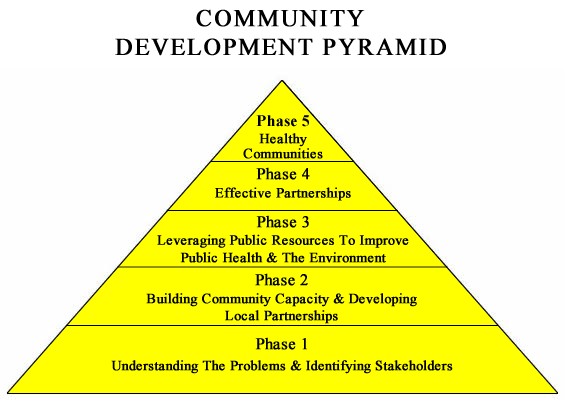Healthy Urban Communities in Connecticut
Community Development Pyramid
Evolution of the Environmental Justice Movement in Hartford, CT Case Study:
During the 1960's and 1970's Hartford lost much of its manufacturing base, and the middle class fled to the suburbs. In 1990, Hartford's population was approximately 130,000 people, with 70% minority including 36% Black and 34% Latino. Residents live in an area of 18.4 square miles with 17 neighborhoods. Hartford is the 8th poorest city in the country and hosts a regional landfill, sewage treatment plant, sewage sludge incinerator, trash-to-energy incinerator, and four small electrical generation plants. The trash-to-energy incinerator contributes 56% of the non-traffic air pollution. Two major interstate highways (I-84 and I-91) border Hartford and four state high-ways traverse the city producing 70% of the mobile source carbon monoxide. Childhood lead poisoning rates are twice the state average. The Connecticut River, an American Heritage River, has a fish consumption alert due to high levels of mercury in the watershed. The Park River and Piper Brook have high bacteria levels and metals contamination from combined sewer overflows, point source and non-point source runoff. Sprawl and lack of investment created 339 acres of vacant land and nearly 1,000 abandoned buildings. Hartford is a city where money is made, but not locally invested.
Click on each phase of the pyramid to examine the role of the EPA and community partners to create a new climate in Hartford where the community's voice influences decisions that are reversing years of environmental injustice and are changing the quality of the environment where they live, work and play.

Click each phase for additional information.
Partners
- B Green 2020
- Brass City Harvest
- Bridgeport Child Advocacy Coalition
- Bridgeport Community Health Center
- Bridgeport Neighborhood Trust
- Bridgeport Public Schools
- Building Parent Power
- The Children's Museum of Connecticut
- Christian Activities Council
- Citizen's Research Education Network
- City of Bridgeport
- City of Hartford
- Clay Arsenal Neighborhood Revitalization Zone
- Community Renewal Team
- Connecticut Bicycle Collaborative
- Connecticut Children's Medical Center
- Connecticut Citizen's Research Group
- Connecticut Coalition for Environmental Justice
- Connecticut Department of Energy & Environmental Protection
- Connecticut Department of Public Health
- Connecticut Indoor Environments Resource Team
- Connecticut River Watershed Council
- Connecticut Voices for Children, Inc.
- Consolidated School Districts of New Britain
- East End Community Council
- East End Neighborhood Revitalization Zone
- Eastern Connecticut Resource and Conservation Development Area
- Fairfield County Environmental Justice Network
- Farmington Avenue Alliance
- Groundwork Bridgeport
- Hartford 2000
- Hartford Area Rally Together
- Hartford Enterprise Zone Business Association
- Hartford Environmental Justice Network
- Hartford Health & Human Services
- Hartford Public Schools
- Hispanic Health Council
- Hartford Hospital
- Knox Parks Foundation
- Ledge Light Health District
- New Haven Ecology Project
- Optimus Health Care, Inc
- Organized North Eastern / Clay Hill and North End
- Park River Watershed Revitalization Initiative
- Pliny Block Association
- Riverfront Recapture
- Southside Institutional Neighborhood Association
- St. Francis Hospital
- UCONN's Environmental Division
- UCONN Environmental Research Institute
- University of Connecticut Cooperative Extension Services
- Upper Albany Merchants Association
- Upper Albany Neighborhood Collaborative
- USDA CT Office
- US HUD CT Office
